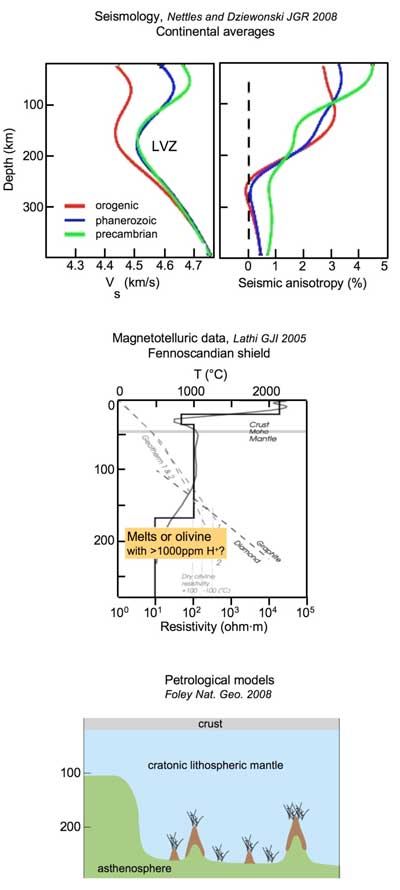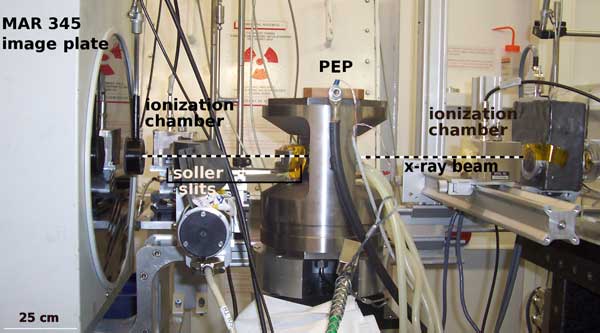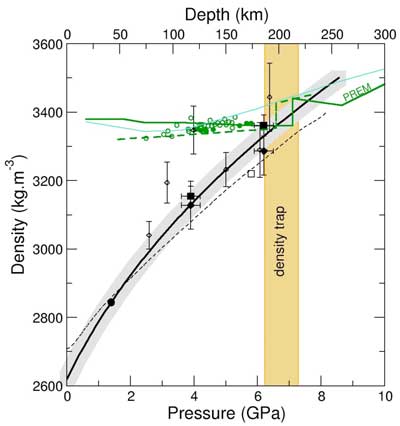 |
Magmas Trapped at the Continental Lithosphere-Asthenosphere Boundary |
C. Crépisson1, G. Morard2, H. Bureau2, G. Prouteau3, Y. Morizet3,4, S. Petigirard5 & C. Sanloup1,6
1Sorbonne Universités, UPMC Univ Paris 06, UMR-CNRS7193, Institut des Sciences de la Terre Paris (ISTeP), F-75005 Paris, France; celine.crepisson@ens.fr ; chrystele.sanloup@upmc.fr
2Sorbonne Universités, UPMC Univ Paris 06, UMR-CNRS 7590, IMPMC, F-75005 Paris, France; guillaume.morard@impmc.jussieu.fr
3ISTO, Orléans, France; gaelle.prouteau@cnrs-orleans.fr ; yann.morizet@univ-nantes.fr
4Universitéde Nantes, UMR-CNRS 6112, LPGN, France
5European Synchrotron Radiation Facility, Grenoble, France; sylvain.petitgirard@uni-bayreuth.de
6CSEC and School of Physics and Astronomy, University of Edinburgh, UK
This webpage is a summary written by C. Sanloup of: Crépisson, C., G. Morard, H. Bureau, G. Prouteau, Y. Morizet, S. Petitgirard, C. Sanloup, Magmas trapped at the continental lithosphere–asthenosphere boundary, Earth Planet. Sci. Lett., 393, 105-112, 2014.
Introduction
The lithosphere–asthenosphere boundary (LAB) beneath the continents is a key interface in plate tectonics yet its nature remains elusive (Eaton, 2009). The presence of partial melts has been advocated to explain the geophysical characteristics of the LAB (Figure 1) but this is the subject of considerable debate essentially because the mechanism to retain melts at depth is unclear. The presence of melts at the cratonic LAB is supported by two main arguments:
- magnetotelluric measurements, which are traditionally explained in terms of an interconnected network of partial melt (Jones et al., 2010); and
- petrological observations that are summarized by O’Reilly (2010) as: “The cratonic LAB probably represents a level where asthenospheric melts have ponded”.

Figure 1: Geophysical and petrological characteristics of the cratonic continental LAB.
Instead of considering primitive mantle melts such as carbonatites, which are too light to be trapped, we have taken a volatile-containing (2-3 wt% H2O+CO2) alkali basalt composition as a proxy for continental LAB melts. The presence of alkali is efficient in increasing melt productivity and lowering the melting point, both being further enhanced by the addition of a few wt% water+CO2 as expected geodynamically, and as required for these basalts to be molten at continental LAB P-T conditions. The genesis of alkali basalts is another debated topic. Nevetheless, a review of recent literature (petrological, experimental and geophysical) supports an origin at depth initiated by melting of recycled altered MORB, and probably involving further reactivity with peridotite (Mallik & Dasgupta, 2013). The precise depth could be as large as 250 km if the initial eclogitic melt was generated at the mantle redox front, the most likely mechanism.
Methodology
We report experimental density measurements on molten alkali basalts at high pressure from two independent methods–X-ray absorption and X-ray diffraction. The latter also reveals the local structure of the melts, and thus the compression mechanisms. High pressure P-T conditions were generated by a Paris-Edinburgh press at the European Synchrotron Radiation Facility in Grenoble, France (Figure 2). The starting glass was loaded in a diamond capsule to limit chemical reactions while minimizing the contribution of the capsule to the signal both in absorption and diffraction. However, the disadvantage of using diamond capsules is that P is fully transmitted through the caps only at elevated temperatures (above 1200 K if using graphite or Pt-Rh caps; van Kan Parker et al., 2010). Using less-compressible caps such as diamond caps (Sakamaki et al., 2013) might prevent full P transmission, resulting in a lower pressure on the sample than applied externally, and thus in lower measured densities particularly at the lowest T investigated.

Figure 2: X-ray absorption apparatus: The intensity of the X-ray beam (dashed line) is measured by ionization chambers located before and after the Paris-Edinburgh press (PEP). The ratio of both measured intensities obeys the Beer-Lambert law and is a function of the sample density. X-ray diffraction apparatus: the diffracted signal is collected on a 2-D MAR345 detector. The Sollers slits are a multichannel collimating system that continuously rotates during data collection, allowing optimization of the sample relative to the background signal. Photo: C. Crépisson.
Results and discussion
We find that alkali basalts are stable at the conditions of the continental LAB both thermally (i.e. they melt at these P-T conditions) and gravitationally (i.e. they are trapped there; Figure 3). We thus provide an answer to the long-standing questions of how melts can be stable in the continental asthenosphere, and what could be the nature of these melts. Besides, stable layers of magmas at depth must exert a strong control on the structure and evolution of the mantle such as chemical filtering, or mechanical shielding of the lithosphere from the convecting mantle that could explain the extreme longevity of cratons (Doglioni et al., 2011). This buoyancy trap would cease to exist at higher mantle temperatures such as those relevant to the Archean, and as such, could be linked to the onset of plate tectonics. Although water has long been held responsible for viscosity softening in the asthenosphere, the latest experimental work shows that neither water, nor a tiny melt fraction (1% level), has much effect (Fei et al., 2013). Thin pockets or a layer of molten basalt could thus provide a better explanation for lithosphere/asthenosphere decoupling below continents from the mid-Archean on. As such, they could have played a major role in the initiation of plate tectonics.

Figure 3: Density of melt as a function of pressure at 1673 K (black filled squares: density from x-ray absorption, black filled diamonds: density from x-ray diffraction, filled circle: calculation at 1.4 GPa for 1.04 wt% dissolved H2O in MORB), compared to seismological models (green solid line: PREM, Dziewonski & Anderson, 1981, blue line: Pacific profile, Ito & Simons, 2011), density model for cratons (green dashed line, Poudjom Djomani et al., 2001), and petrological values of the density for surrounding rocks (filled green circles: harzburgite xenoliths, open green circles: lherzolite xenoliths, James et al., 2004). Black solid line: third order Birch-Murnaghan equation of state through our density data +1.4 GPa estimate. The gray zone shows the effect on this equation of state for T variations of ±100 K. These reflect the range of T reported for the continental LAB. Open diamonds: shock-wave data on molten MORB (Rowan, 1993), black dashed line: shock-wave equation of state measured on Anorthite36–Diopside64 melt and applied to a MORB composition (Rigden et al., 1984), open square: sink-float data on molten MORB (Agee, 1998).
References
- Agee, C.B., 1998. Crystal–liquid density inversions in terrestrial and lunar magmas. Phys. Earth Planet. Inter. 107, 63–74.
- Eaton, D.W., Darbyshire, F., Evans, R.L., Grutter, H., Jones, A.G., Yuan, X., 2009. The elusive lithosphere–asthenosphere boundary (LAB) beneath cratons. Lithos 109, 1–22.
- Doglioni, C., Ismail-Zadeh, A., Panza, G., Riguzzi, F., 2011. Lithosphere–asthenosphere viscosity contrast and decoupling. Phys. Earth Planet. Inter. 189, 1–8.
- Dziewonski, A.M. and Anderson, D.L., 1981. Preliminary reference Earth model. Phys. Earth Planet. Inter. 25, 297–356.
- Fei, H., Wiedenbeck, M., Yamazaki, D., Katsura, T., 2013. Small effect of water on upper-mantle rheology based on silicon self-diffusion coefficients. Nature 498, 213–216.
- Foley S.F., 2008. Rejuvenation and erosion of the continental lithosphere. Nat. Geosci. 1, 503-510.
- James, D.E., Boyd, F.R., Schutt, D., Bell, D.R., Carlson, R.W., 2004. Xenolith constraints on seismic velocities in the upper mantle beneath southern Africa. Geochem. Geophys. Geosys. 5, Q01002.
- Ito, T., Simons, M., 2011. Probing asthenospheric density, temperature, and elastic moduli below the western United States. Science 332, 947–951
- Jones, A.G., Plomerov, J., Korja, T., Sodoudi, F., Spakman, W., 2010. Europe from the bottom up: A statistical examination of the central and northern European lithosphere–asthenosphere boundary from comparing seismological and electromagnetic observations. Lithos 120, 14–29.
- Lahti I., Korja T., Kaikkonen P., Vaittinen K. and BEAR Working Group, 2005. Decomposition analysis of the BEAR magnetotelluric data: implications for the upper mantle conductivity in the Fennoscandian Shield. Geophys. J. Int. 163, 900-914.
- Malik, A., Dasgupta, R., 2013. Reactive infiltration of MORB-eclogite-derived carbonated silicate melt into fertile peridotite at 3 GPa and genesis of alkalic magmas. J. Petrol. 54, 2267–2300.
- Nettles, M. and Dziewonski, A.M., 2008. Radially anisotropic shear velocity structure of the upper mantle globally and beneath North America. J. Geophys. Res. 113, B02303.
- O’Reilly, S.Y., Griffin, W.L., 2010. The continental lithosphere–asthenosphere boundary: Can we sample it?. Lithos 120, 1–13.
- Poudjom Djomani, Y.H., O’Reilly, S.Y., Griffin, W.L., Morgan, P., 2001. The density structure of subcontinental lithosphere through time. Earth Planet. Sci. Lett. 184, 605–621.
- Rigden, S.M., Ahrens, T.J., Stolper, E.M., 1984. Densities of liquid silicate at high pressures. Science 226, 1071–1074.
- Rowan, L., 1993. I. Equation of state of molten mid-ocean ridge basalt. II. Structure of Kilauea volcano. PhD thesis. California Institute of Technology.
- Sakamaki T., E. Ohtani, H , Terasaki, S. Urakawa, Y. Katayama, K-i. Funakoshi, Y. Wang and J.W. Hernlund, 2013. Ponded melt at the boundary between the lithosphere and asthenosphere. Nat. Geosci., 6, 1041–1044.
- Van Kan Parker, M., Sanloup, C., Tronche, E.J., Perrillat, J.P., Mezouar, M., Rai, N., van Westrenen, W., 2010. Calibration of a diamond capsule cell assembly for in situ determination of liquid properties in the Paris–Edinburgh press. High Press. Res. 30, 332–341.
last updated 13th September, 2014 |
